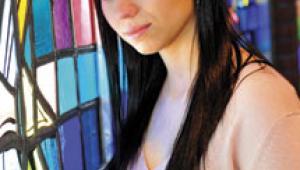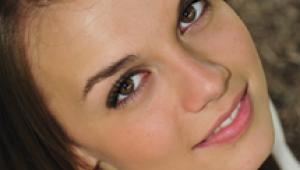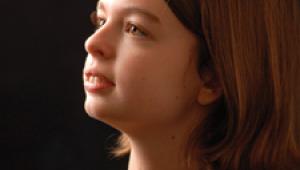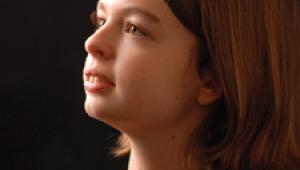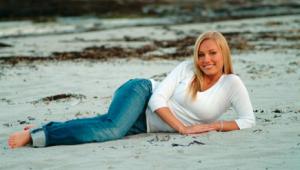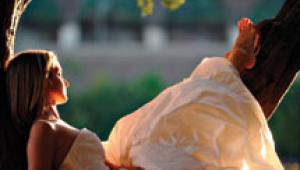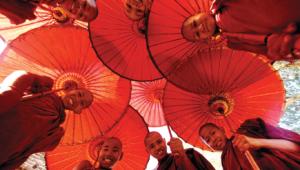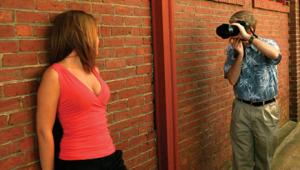Wedding And Portraiture
Take Control Of Your Background
It may surprise you that many people taking pictures today are quite shocked when they see the results of their efforts. "That isn't what I saw when I took the picture!" they say. Or worse: "How did this happen?" These are only a couple of the comments that I hear frequently from photographers who haven't quite grasped onto the idea that they have the ability to control the detail in backgrounds. They just have to understand their own responsibility in achieving the final results. This was brought sharply to my attention recently when I photographed a neighbor's visiting children and grandchildren a few minutes before they went out. I wanted to show them in the Florida environment, yet still wanted the people to stand out in the pictures more than the background. The choice of location was simple. I would photograph them in the screened-in lanai area behind their home. At the same time, I had to consider the lighting on their faces. I chose my first location considering (first) an appropriate background and (second) good, natural lighting on the subjects' faces. My decision was to position the family so that the light would be coming from behind them and from the side. That would tend to create depth, texture, and detail. At the same time, everyone would be looking toward a dark area. That would mean that there would be no squinting of the eyes from the bright morning sun. There had been no prior discussion of clothing. They were all dressed to go out for Sunday brunch. The only thing that I changed was to have the two men take off their navy blue sport jackets. They were simply "out-of-key" with the light colors that everyone else was wearing. I explained the situation to them. No problem. The jackets came off and everyone seemed to blend together much better for the picture. |
|||
Exposure Considerations I explained to everyone before I took the picture that I was going to record great detail in the people, while creating a background that would be so light it would be almost nonexistent. This would focus the attention directly onto the family. At the same time, however, you would still get the feeling of the Florida location. Two armchairs that were already there had to be moved only slightly to pose the group exactly where I wanted them. I began the arrangement by having the finished composition in mind before I even began to seat them. First, I sat the parents, placing the grandparents in the center of the picture. I then added the boys on each side, placing the youngest of the children front and center. I roughly composed the group through the viewfinder of my 28-135mm Canon zoom lens until I liked the space around them. I finally started the refinement of the group by posing each of their feet. Then, I did the last minute "touch-ups" by connecting them all with their hands and arms. (You can usually tell my family groups by the way I have each of the family members reaching out to each other.) Expressions were up for grabs, especially with the youngest. A stranger in their midst, and they were expected to smile? Well, we'd see. I actually ended up trying to get everyone's attention by balancing things on my head. The boys thought I looked stupid. The little girl seemed quizzical, but the adults smiled and looked good. My main problem was to keep the adults looking at the camera and not at the children to see how they were reacting. Been there. Seen that, huh? I made a test shot with a slight adjustment in exposure. I showed it to them and we were off and running (#1). How about a picture (#2) of just the five of them? Okay. Let's see what we can do. By this time my balancing act had worn thin, but there was no delay, since the exposure was the same and the composition fell together pretty quickly. I used the simple, natural light. Al-though they were basically backlit, there was definitely bright light coming around on both sides of the group. It just doesn't get any easier than this, I thought. |
|||
The "Sunny 16" Rule Works
Again! I set the camera manually to 1/125 at f/16--my normal exposure for bright, sunny locations--and pulled two pool armchairs to the location I had chosen. Again, I began by seating the parents, adding the grandparents in the center and then bringing the children into the composition. Bodies were turned toward the camera. I had everyone sitting up straight and leaning slightly toward my camera. Hands and arms, of course, were all positioned very deliberately to achieve a unified family feeling in picture (#3). Squinting now became a problem. Although everyone was turned away from the direct sunlight, the light bouncing off the bright setting all around them made it difficult for them to open their eyes. As the older boy suggested, I counted to "three." Most of them were able to open their eyes and smile on the final count€but not the young boy to my left. Oh well, at least the exposure was perfect. I liked the picture, even though there were still some hot spots on a few of the faces from the sun (which was almost directly overhead). |
|||
Out-Think The Camera? Not
Me! No problem. It was a beautiful balance of sunlight and flash. What I didn't find out until later when David Carlson, the regional Canon rep explained it to me, was that the flash works together with the Canon D30. Together, they automatically go into what is called the ETTL mode. That stands for "Evaluated Through The Lens." The built-in exposure system reads the light on the subjects and the light on the background and puts in exactly the amount of flash you need to accomplish the perfect balance. Of course, you can override the flash if you want to, but why fight city hall if it works right from the get-go as in #4? Notice that when the light on their faces is built up by the addition of the flash to the ambient light, the background goes a little deeper. That's why you need to have a bright background to begin with. Had we been shooting into dark trees, the background would have gone too dark. As it was, everything (except the one kid's squinting eyes) was perfect. At least I gave them the opportunity to select from one or the other types of backgrounds. |
|||
Balance The Light By this time they were pushing me to leave the house. They didn't want to be late for their plans for the day. Again, no problem. I knew that if I could pose them in a location where I would have the same amount of light on the background as I had on their faces that it would be a slam-dunk. And it was. I sat her in a chair, posed her husband on the arm and leaned them together, his head slightly higher than hers. A couple of quick exposures and they were off as in #5. I knew when I took the picture that I would have to remove the brass door handles behind him. Perhaps, even remove a wall hanging behind her. Hey, in Photoshop, it's a matter of just a few minutes. The simple background was all that I wanted and just what I got. As a matter of fact, the simplicity of the whole family sitting was just what I wanted. I controlled the background. I controlled the foreground. The only thing that I really couldn't control was the adults. They still kept looking to see how the kids were doing. |
|||
How'd We Do? In the second location the background was brightly lit by direct sunshine. I exposed for the bright background and let the camera automatically do its thing on the faces. Without the automatic feature of the camera, the faces would have still fairly well matched the exposure of the background, since the area reflected so much light back into their faces. With the flash added, the balance was even nicer. The people jump out beautifully in the picture, the background goes just a little bit deeper. In the final phase of the portrait session I posed the couple where their faces and the background were receiving the same amount of light. Result: perfect detail throughout the entire image. This taught me that I could just about control the brightness of the background in all my pictures. As long as I printed for the faces, I could always know what was going to happen behind them. No guesses. No surprises. And The Result Is€ Their only problem was that they hadn't thought in advance to bring matching clothing for them all. "No problem!" I told them. "Let's do a pool portrait!" So, even though the outside temperature was in the low 70s, they all agreed to lower themselves into the pool just long enough for me to take a picture as shown in #6. No clothes to worry about, so it was easy in that department. Exposure was easy, too, of course. I set the camera in its fully automatic mode, attached the flash on top and simply let the camera do its thing. Hey, it really doesn't get any easier than that. What a great memory of their visit to Grandma and Grand-pa's house. Finally, be sure to check out my web site at: www.zuga.net |






